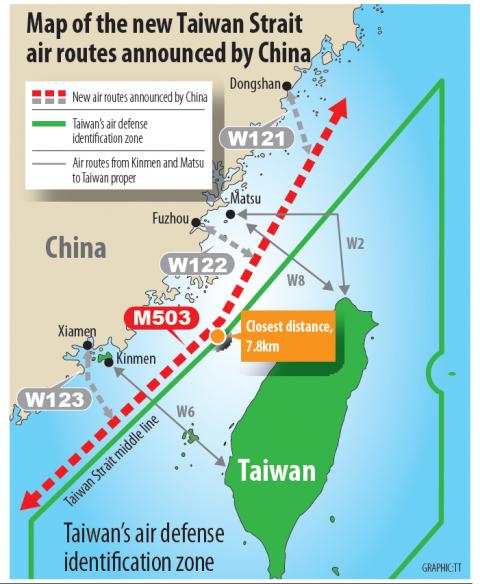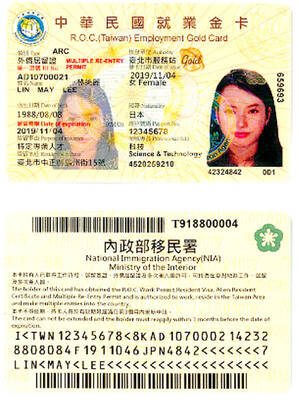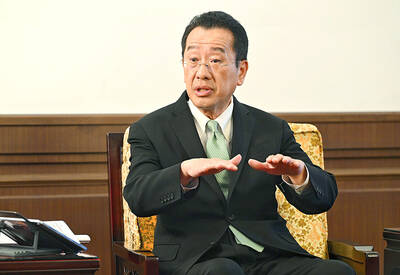Consensus was reached yesterday during a cross-strait meeting in Shanghai on Beijing’s four proposed new flight routes, with the Chinese agreeing to delay implementation of the most controversial route and temporarily freeze the others, the Civil Aeronautics Administration (CAA) said.
Beijing’s announcement on Jan. 12 of the new routes just west of the Taiwan Strait’s median line — the M503 route, which would hug the median line, and three feeder routes — W121, W122 and W123 — that would connect with M503, aroused strong opposition in Taiwan.
There was widespread anger over Beijing’s unilateral move amid concern that it would infringe on the nation’s sovereignty and that the proposed routes, especially W122 and W123, could interfere with flights to Kinmen and Matsu.

The M503 route is only 7.8km from the median line.
The government also cited flight security issues in the event of bad weather and said the new routes might overlap with Taipei’s flight information region.
The flight paths were originally to go into operation on Thursday.
CAA Director-General Lin Tyh-ming (林志明) said that China has agreed to move the flight path of the M503 route 6 nautical miles (11km) to the west and to use it solely for one-way flights from north to south, with planes to be redirected to fly over the Chinese coast in case of emergencies.
Lin also said that the M503 flight path would only become official after China has conducted actual test flights of the path.
The Chinese adjustments to the flight path are understandable, but further negotiation should be held across the Strait, the CAA said.
China’s Taiwan Affairs Office (TAO) issued a statement in Beijing saying that it was certain that Taiwan understands more about the proposed flight routes and is fully cognizant of China’s goodwill after flight agencies from each side of the Taiwan Strait met to discuss the issue yesterday.
However, the press release made no mention of the TAO’s decision to delay implementation of the M503 flight route, as the CAA reported.
Beijing has said that the flight paths were “necessary for economic and social development as well as flight security.” It said its A470 flight path is so congested, raising concern about flight safety that it has been nicknamed the “Black Star” flight path by the International Federation of Airline Pilots Associations, so the M503 is necessary, the Chinese government said.

GAINING STEAM: The scheme initially failed to gather much attention, with only 188 cards issued in its first year, but gained popularity amid the COVID-19 pandemic Applications for the Employment Gold Card have increased in the past few years, with the card having been issued to a total of 13,191 people from 101 countries since its introduction in 2018, the National Development Council (NDC) said yesterday. Those who have received the card have included celebrities, such as former NBA star Dwight Howard and Australian-South Korean cheerleader Dahye Lee, the NDC said. The four-in-one Employment Gold Card combines a work permit, resident visa, Alien Resident Certificate (ARC) and re-entry permit. It was first introduced in February 2018 through the Act Governing Recruitment and Employment of Foreign Professionals (外國專業人才延攬及雇用法),

RESILIENCE: Deepening bilateral cooperation would extend the peace sustained over the 45 years since the Taiwan Relations Act, Greene said Taiwan-US relations are built on deep economic ties and shared values, American Institute in Taiwan (AIT) Director Raymond Greene said yesterday, adding that strengthening supply chain security in critical industries, enhancing societal resilience through cooperation and deepening partnerships are key to ensuring peace and stability for Taiwan in the years ahead. Greene made the remarks at the National Security Youth Forum, organized by National Taiwan University’s National Security and Strategy Studies Institution in Taipei. In his address in Mandarin Chinese, Greene said the Taiwan-US relationship is built on deep economic ties and shared interests, and grows stronger through the enduring friendship between

CAUTION URGED: Xiaohongshu and Douyin — the Chinese version of TikTok — are tools the Chinese government uses for its ‘united front’ propaganda, the MAC said Mainland Affairs Council (MAC) Minister Chiu Chui-cheng (邱垂正) yesterday urged people who use Chinese social media platforms to be cautious of being influenced by Beijing’s “united front” propaganda and undermining Taiwan’s sovereignty. Chiu made the remarks in response to queries about Chinese academic Zhang Weiwei (張維為) saying that as young Taiwanese are fond of interacting on Chinese app Xiaohongshu (小紅書, known as RedNote in English), “after unification with China, it would be easier to govern Taiwan than Hong Kong.” Zhang is professor of international relations at Shanghai’s Fudan University and director of its China Institute. When giving a speech at China’s Wuhan

ENHANCE DETERRENCE: Taiwan has to display ‘fierce resolve’ to defend itself for China to understand that the costs of war outweigh potential gains, Koo said Taiwan’s armed forces must reach a high level of combat readiness by 2027 to effectively deter a potential Chinese invasion, Minister of National Defense Wellington Koo (顧立雄) said in an interview with the Chinese-language Liberty Times (sister newspaper of the Taipei Times) published yesterday. His comments came three days after US Secretary of State Marco Rubio told the US Senate that deterring a Chinese attack on Taiwan requires making a conflict “cost more than what it’s worth.” Rubio made the remarks in response to a question about US policy on Taiwan’s defense from Republican Senator John Cornyn, who said that Chinese